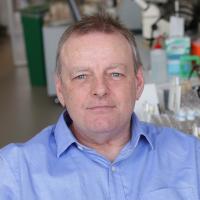About Andrew Tomlinson
Casting Light on the Evolution Development of the Eye
By tracing the growth of cells that respond to light in the fruit fly eye, Andrew Tomlinson, PhD, is uncovering striking similarities to our own eye development.

The eye is an extraordinary thing: a living lens made of millions of parts, coming together to bring the world around us into focus. Explaining the origins of this marvelously complicated machine has been a long-running obsession of scientists — from Charles Darwin, who believed that the eye evolved in small steps, to geneticist Andrew Tomlinson, PhD, who has recently traced some of those steps.
A principal investigator at Columbia University’s Mortimer B. Zuckerman Mind Brain Behavior Institute, Dr. Tomlinson explores how the cells that respond to light are made and assembled into a functioning retina. His work studies not just how eyes develop in each individual, but asks how those eyes have changed over the eons of evolution.
“Every immature cell in an embryo has a fate, whether it’s to become a cell in the eye or in the heart,” says Dr. Tomlinson. “I study how the cells reach their destinies, through processes that have long been mysterious.”
To understand how cells in our bodies mature, Dr. Tomlinson focuses on the genes that guide this in the fruit fly. The genes of humans and flies are remarkably similar, even though the two species are separated by hundreds of millions of years of evolution.
“The fly is the best tool to answer the biggest and most fundamental questions about growth and development, because that knowledge can then be applied to understanding the development of more complex organisms — even humans,” says Dr. Tomlinson, who is also a professor of genetics and development at Columbia University Irving Medical Center. “For example, almost all the major genes that guide our own development — which bear such whimsical names as Wingless, Hedgehog and Frizzled — were first discovered in the fly.”
Dr. Tomlinson began his career at the dawn of the molecular revolution, when new tools helped scientists to more precisely unravel the function of genes in living organisms. He investigated a type of nerve cell located in the eye called a photoreceptor. Photoreceptors sense light and convert information about that light into electrical signals sent to the brain. The fly eye contains eight photoreceptors; and Dr. Tomlinson was particularly intrigued by the photoreceptor that see ultra violet light, known as R7. Work by Dr. Tomlinson and others showed that the development of this cell was not as simple a process as that of other cells.
“For some cells, the developmental path from stem cell to maturity is relatively straightforward,” he says. “Genes within the maturing cell switch on at precise intervals to guide development. But R7 cells are more complicated.”
Through the course of his research, Dr. Tomlinson discovered that developing R7 cells receive and incorporate highly complex signals from neighboring cells; this communication is critical for healthy eye development. In his report of these findings in 2013, he described how one of these signals is generated by a gene called Notch.
“Notch is one of the most important genes in biology,” says Dr. Tomlinson. “It acts like a genetic Swiss army knife that helps to build many different biological systems in nearly every living organism, from flies to people and everything in between.”
Often, Notch’s job is to act like a brake pedal at key moments to ensure proper development. But Dr. Tomlinson found that, in R7 receptors, it could also act like the gas.
“To guarantee R7 development, Notch sends multiple competing signals: some that say ‘go’ and others that say ‘stop,’” says Dr. Tomlinson. “The fact that this occurs at all was stunning; there was no obvious logic behind it.”
This multitasking revealed evolution’s thrifty side: its ability to build something complicated, like the eye, by tasking one gene with more than one job. Complexity and simplicity come together in R7, a puzzle that Dr. Tomlinson continues to piece together.
“One thing that’s been born out of my research is that for every question I answer, two more arise,” he says.
Even after decades of research, Dr. Tomlinson is still awed by the elegance of the eye — and its components. He can often be found at the microscope in his lab, peering at developing photoreceptors: cells stained to glow with bright colors that could be mistaken for abstract art.
“Even after all these years, this work excites me,” he says. “There are so many complex mysteries left for us to solve, and in that mysterious complexity, I see such immeasurable beauty.”
Selected Publications
-
R7 Photoreceptor Specification in the Developing Drosophila Eye: The Role of the Transcription Factor Deadpan.
Mavromatakis YE,
PLoS Genet.2016 Jul 18
-
Wingless mediated apoptosis: How cone cells direct the death of peripheral ommatidia in the developing Drosophila eye.
Kumar SR, Patel H,
Dev Biol.2015 Nov 15
-
Switching cell fates in the developing Drosophila eye.
Mavromatakis YE,
Development.2013 Nov
-
The role of the small GTPase Rap in Drosophila R7 photoreceptor specification.
Mavromatakis YE,
Proc Natl Acad Sci U S A.2012 Mar 6
-
Three distinct roles for notch in Drosophila R7 photoreceptor specification.
Tomlinson A, Mavromatakis YE, Struhl G
PLoS Biol.2011 Aug
